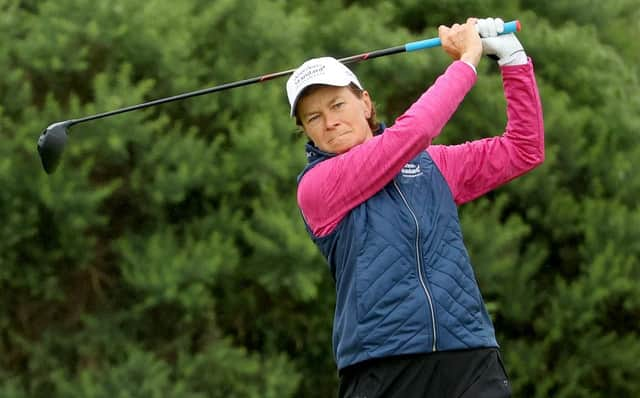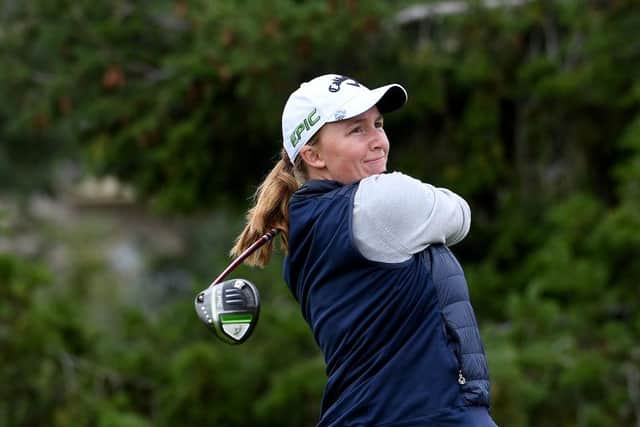Martin Dempster: Why I owe Catriona Matthew a debt of gratitude


It was almost 28 years ago, but I still remember it vividly. The day when the North Berwick player won her third Scottish Women’s Amateur Championship as she beat Valerie Melvin by one hole in the final at Gullane.
Prior to that, the only time I’d properly watched women playing golf was in a caddying role in an event called the Ford Home Internationals, which involved club players.
Advertisement
Hide AdAdvertisement
Hide AdI was working for my local paper, the Berwickshire News & East Lothian Advertiser, at the time and two players, one from Eyemouth and the other from Duns, had qualified for a Scottish team that was captained by the Ryder Cup player, George Will.
The four-cornered event was held at Royal Lytham and what a blast that was, but, with all due respect to those involved, seeing Matthew in action for the first time a few years later was a real eye-opener.
It was how effortless she made swinging a golf club look yet still having lots of oomph, as I certainly recall from subsequently having the pleasure of playing in the same group as the major winner in a couple of media events over the years.
The same, incidentally, can be said of similar enjoyable experiences with Matthew’s fellow Scots Kelsey Macdonald, Kylie Henry and Carly Booth (apologies if I’ve forgotten anyone), as well as Dane Iben Tinning, Frenchwoman Gwladys Nocera and, most recently, England’s Meghan MacLaren.
On each and every occasion I have played with a woman professional, and leading amateurs, too, for that matter, I was left truly and utterly baffled as to why it seemed, at least in the early part of my career, that some of my fellow golf writers were reluctant to give credit where it was clearly due.


“You just wouldn’t see that in the men’s game, certainly not at tour level,” observed one such individual on seeing a poor chip, I think, as we were covering a women’s amateur event in Scotland a few years back, and that comment has stuck in my mind ever since.
Thanks mainly to Matthew, I’ve personally enjoyed reporting on Scottish successes in particular in the women’s game over the years, both in the amateur and pro ranks, and, as on the men’s side, we have some fantastic ambassadors.
Some exciting young talent, too, in the likes of Louise Ducan and Hannah Darling, the current Women’s Amateur and Girls’ Amateur champions respectively, and what a terrific time for them to be showing great potential.
Advertisement
Hide AdAdvertisement
Hide AdYes, they are still in the amateur ranks this year, but a number of recent announcements have certainly signalled that, financially, things are finally moving in the right direction across the board in women’s golf.
The 2022 LPGA schedule is set to boast a record $90.5 million in official purses across 34 events. Players on the LET, meanwhile, will compete for a minimum of €24.5 million across 31 events, including the $2m Trust Golf Women’s Scottish Open at Dundonald Links. To put the latter into perspective, that’s €4.5m up on 2021 and €13m more than in 2019.
On the major front, the R&A had led the way by increasing the prize pot for last year’s AIG Women’s Open at Carnoustie to $5.8m, rising to $6.8m for this year’s ground-breaking visit to Muirfield.
Now, in another huge boost, the USGA has just announced that, thanks to ProMedica, a mission-based, not-for-profit integrated health and well-being organisation, being welcomed on board as a ‘presenting partner’, the purse for the 2022 edition of the US Women’s Open will nearly double, increasing by $5,5m to $10m, this year then rise to $12m over the next five years.
“It’s a big moment for our sport but also for women’s sport in general,” said Gemma Dryburgh, the Scottish No 1 and a full card holder again on the LPGA Tour, of the US Women’s Open announcement.
“To have a tournament raise the stakes as much as that is amazing and I truly believe we deserve the opportunity to compete for that kind of money. I’m sure this move from the USGA will encourage the other majors and the regular tour events to increase their prize funds, too. It just moves the whole sport in the right direction.”
About time, too, though let’s not be fooled into thinking that the vast majority of women professionals are suddenly going to have their lives transformed.
The aforementioned MacLaren recently highlighted how, without sponsorship or other income, she would have suffered a loss of £23,000 last year despite finishing in the top 20 on the Symetra Tour, the LPGA’s feeder circuit.
Advertisement
Hide AdAdvertisement
Hide Ad“I definitely could relate to Meghan’s tweet,” added Dryburgh. “I would say my first three years as a pro I managed to break even or suffer just a small loss, but that was only due to help from my parents, sponsors, Scottish Golf, and the members at my club setting up a trust fund for me in my first few years on tour.
“Without all of that help, I wouldn’t have been able to continue playing. Sponsorship and help from national organisations is so key to help players make the transition from amateur to professional as it really is difficult until you’ve established yourself on one of the main tours.”
Like Matthew did on the LPGA and, though too late for her, here’s hoping that some Scots can literally cash in on an exciting new chapter for women’s golf.
A message from the Editor:
Don't miss out on a 30 per cent discount on an annual sports subscription. We have a special offer throughout January where you can get a reduced package. Visit https://www.scotsman.com/subscriptions/sports for more details
Comments
Want to join the conversation? Please or to comment on this article.
